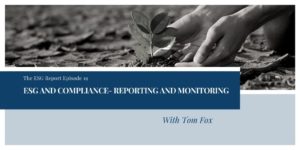
Tom Fox believes that the compliance department is best positioned to lead the ESG function, and in this solo episode, he continues to explain why. He focuses on reporting and ongoing monitoring which, he says, should lead to continuous improvement.
ESG Reporting
At first glance, ESG reporting may seem outside the scope of the compliance professional; if you look deeper, however, you’d realize that it’s a large part of what they do every day. Compliance understands and leads the process of detailed documentation in order to satisfy regulatory requirements. The problem for ESG is that there are no universally accepted reporting standards. Regulatory bodies around the world, particularly in the EU, have started to come out with ESG reporting frameworks, so the process is evolving. Compliance professionals should keep abreast of these developments. Tom comments that many companies are already doing ESG reporting in some form, as evidenced by their corporate reports which include ESG information. This matters, he says, because “companies with good ESG practices have lower cost of capital, better operational performance, and better share price.” These companies also are more attractive to investors and potential employees.
ESG Reporting for Compliance Professionals
What should compliance professionals think about with regard to ESG reporting? Tom lists 6 key areas, including:
- understand what your company is already doing on sustainability;
- carry out an assessment of stakeholder ESG behaviors;
- don’t disregard sustainability as simply a cost, but see it as a way to make you a better company.
The efforts you make as a company to operate sustainably impact the wider community, and your reports are a way to have those efforts acknowledged. “The bottom line is that much of the work done by compliance can be used as a basis for your ESG reporting,” Tom reminds listeners. “Verifiable ESG reporting …allows stakeholders to compare performance and make meaningful decisions. Transparency is critical to the process. …This transparency and its reporting enables shareholders and stakeholders to gain a clearer picture of companies direction and progression.” He shares some additional ways companies can improve their ESG reporting, including integrating ESG data and mindset into everyday business operations.
ESG Monitoring
You can’t manage what you don’t measure, Tom points out. Shareholders, investors, and stakeholders want to confirm that a proper plan is in effect to monitor ESG KPIs. Companies that take ESG seriously must have a central management committee. “The key is a standardized approach to ESG data collection and monitoring; this is because, without standardization leading to consistent reporting practices across an organization, it can be challenging to understand and compare performance progress towards targets,” he explains. Your framework must include quantitative and qualitative metrics. He gives some examples of ESG metrics, including those set by the World Economic Forum. These ideas are nothing new to compliance professionals, he remarks; another reason why they are best suited to lead the ESG function.
Resources
Tom Fox email
FCPA Compliance and Ethics blog


